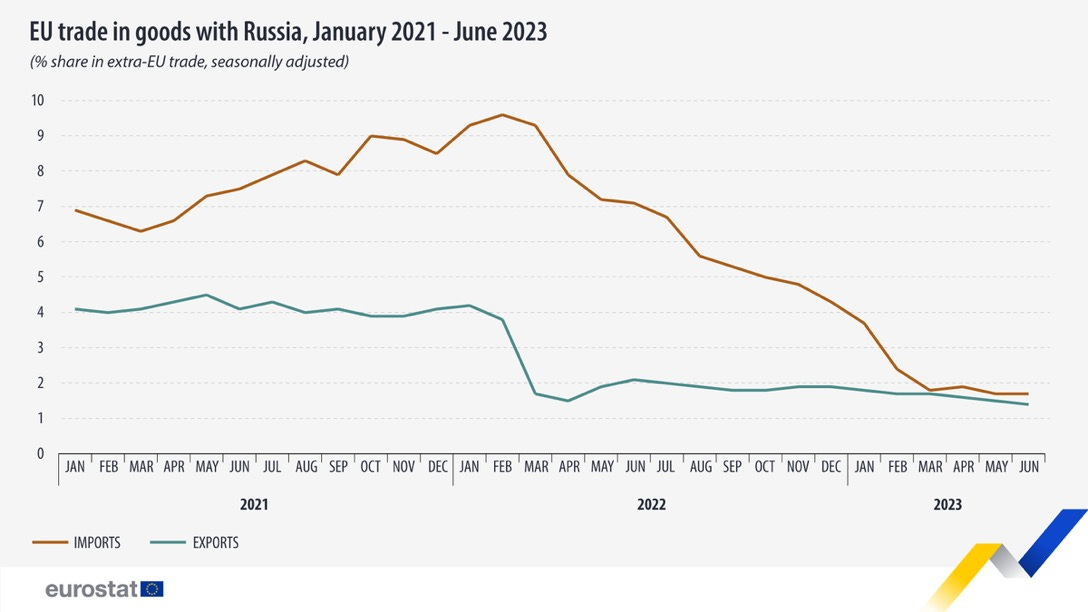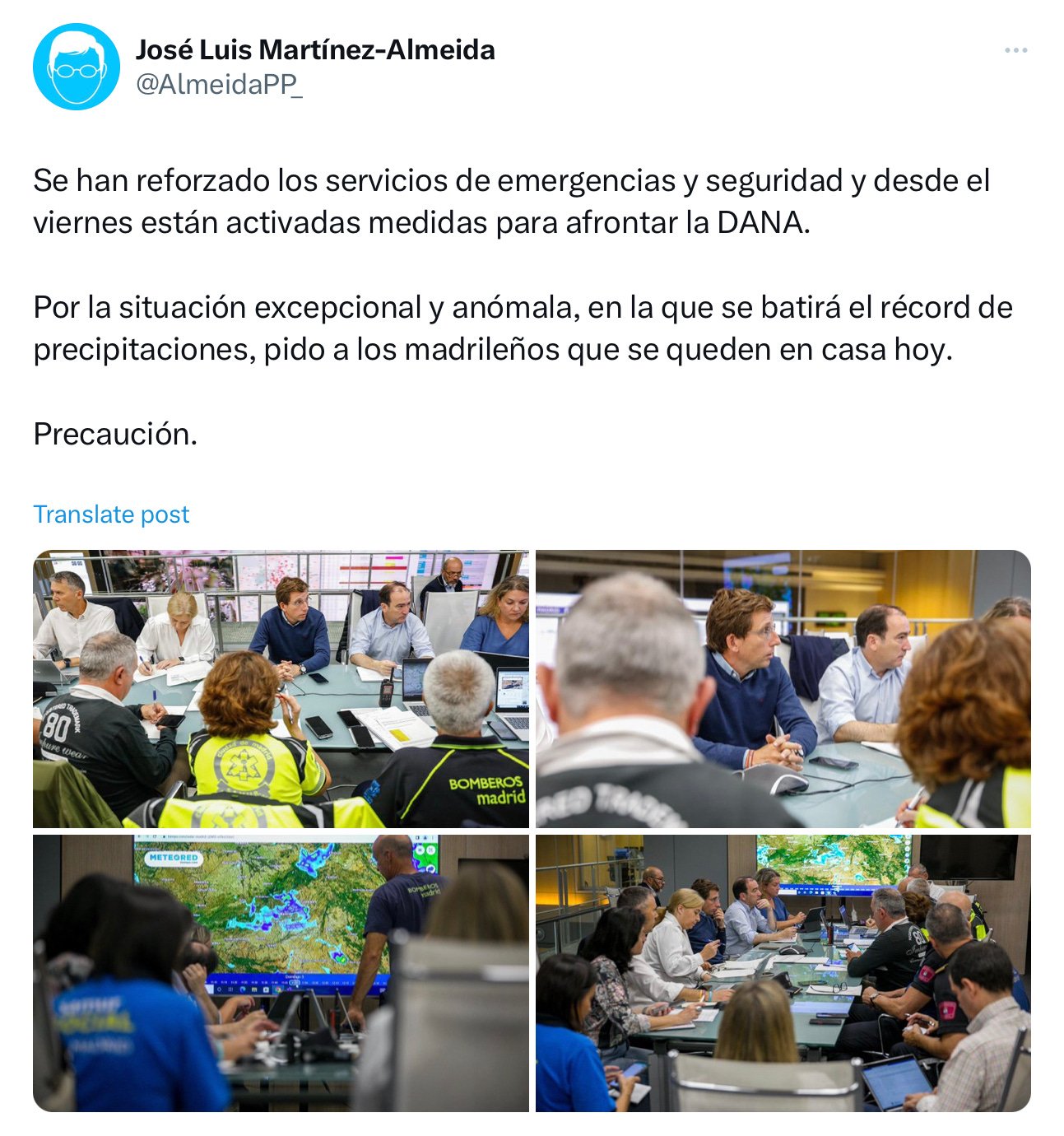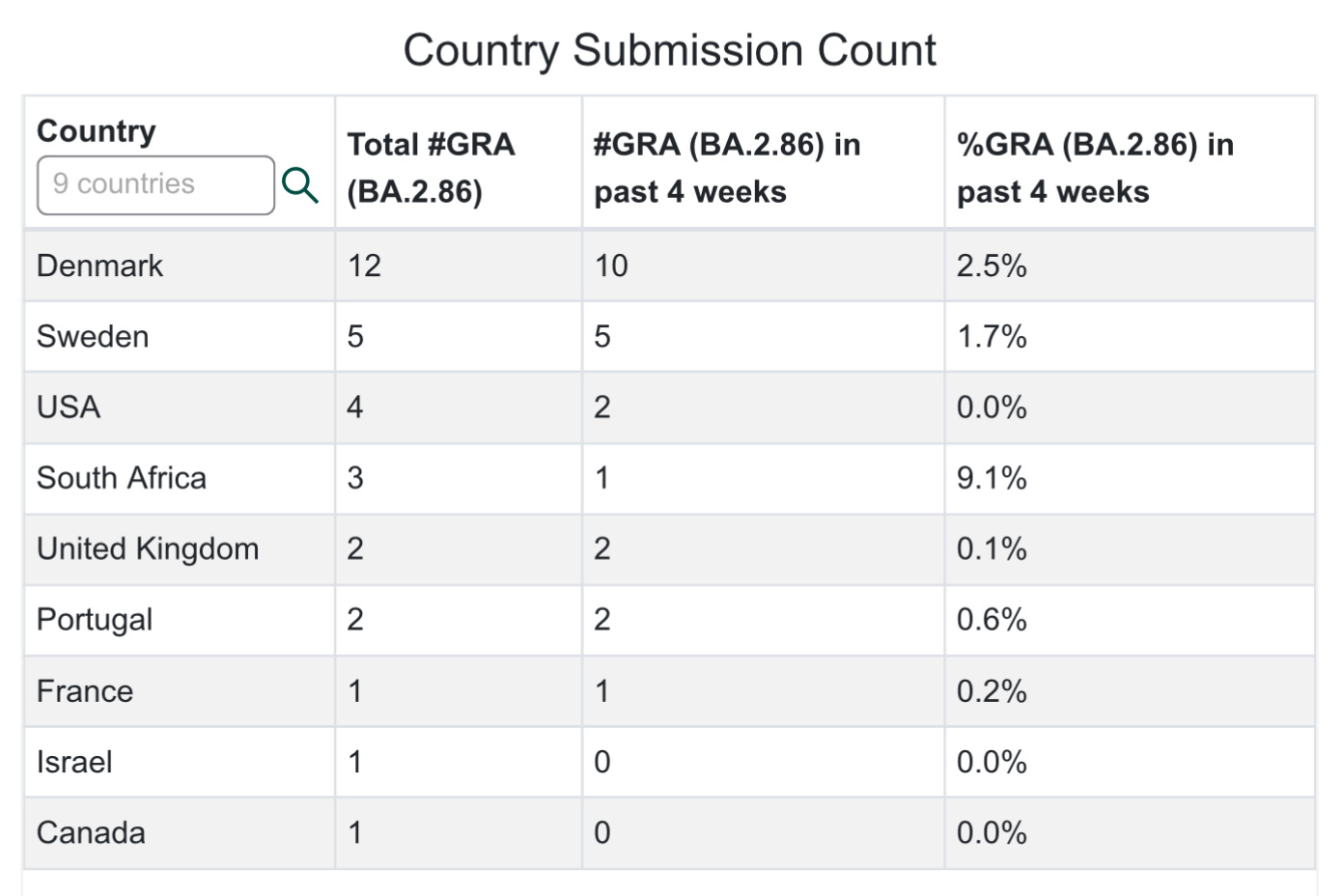🍃Environment & Energy⚡️
🇪🇺
The European Union continues to move away from fossil fuels. According to a study from Ember, a clean energy think tank, the EU has seen a 17% drop so far this year in electricity produced using coal, oil, or gas.
The think tank says it is “very likely” fossil fuel-driven electricity production has sunk back to levels not seen since 2000.
The study points to the transition to clean energy and an overall falling demand for electricity for the drop in fossil fuel-generated power production.
The European Union has pledged to cut its greenhouse gas emissions by at least 55% from 1990 levels by 2030 and be totally carbon neutral by 2050.
At the individual country level, the report said that fossil fuel+generated electricity production fell to the lowest levels so far this century in seven European nations. They are Austria, the Czech Republic, Denmark, Finland, Italy, Poland and Slovenia. Fourteen nations registered the lowest fossil fuel power generation on record.
But there is more work to be done according to the Centre for Research on Energy and Clean Air (CREA). Energy Analyst Petras Katinas, who co-authored the Ember study, says the EU remains too addicted to fossil fuels.
“The EU’s reliance on fossil fuels persists. This dependence extends to external sources as well. Given that a significant portion of the EU’s fossil fuel needs are met through imports from third countries, a vulnerability exists. Even a minor disruption in the supply chain could lead to price hikes and potential energy shortages.”
The Ember study determined that solar power production increased by 13% in Europe year over year. Wind energy production was up 5%. Hydropower grew by 11%.
Several countries shattered green power production records. Denmark and Portugal both saw over 75% of their power come from renewables. While Greece and Romania surpassed 50% for the first time.
The authors of the report are urging the EU to keep the pedal to the metal by putting up more wind turbines, installing more solar panel farms, expanding the electricity grid, and building battery storage farms to store power for use on demand. They also urged that the European government streamline permitting processes for clean energy infrastructure.
“We shouldn’t be complacent about the winter ahead. You need to keep pushing.”
🇪🇺🇷🇺
European sanction on Russia for its illegal invasion of Ukraine continue to erode trade between Russia and the European Union. According to European statistics agency EuroStat Russia’s share in extra-EU imports has fallen from 9.6% in February of last year to just 1.7% in June of 2023. Export numbers also shrank to 1.4% in the same period.
Russia’s efforts to weaponize its energy exports to try and bring Europe to heel have also spectacularly backfired. The trade deficit with Russia, largely to do with energy products, went from €18.5 billion in March 2022 the month before the invasion of Ukraine to €0.4 billion by June of this year.
Specifically, in the last two years, European petroleum imports from Russia have dropped 27% (29.2% in 2021 to 2.3% in 2023). Natural gas imports have fallen by 26% and coal by 45%.
🇩🇰
In Denmark the church is joining the fight against climate change. The Danish People’s Church is the third largest landowner in the country with about 11,000 hectares of land.
Bishop of the Viborg Diocese, and Chair of the Folkkirkens Green Omstilling, Henrik Stubkjær told Ritzau that the church has a duty to use its lands to help reach Denmark’s climate goals by 2030.
“We are Denmark's largest organization. 72% of Danes are members. We have an obligation to take care of the land we have been given, and make sure to pass it on in good condition to the next generation.”
Church lands will be mapped out and assessed to see where forests can be planted, organic farming can be set up, solar cell farms or wind turbines installed, and nature restoration carried out.
Denmark has pledged to reduce its CO2 emissions by 70% below 1990 levels by 2030 and be completely carbon neutral by 2050.
-
Butterfly populations in Denmark have been decimated and efforts to protect them have failed utterly. That is the conclusion of a comprehensive study from the University of Copenhagen.
Biologist Emil Blicher Bjerregård:
"For the 22 butterfly species that we have been monitoring, their distribution on Zealand, Lolland, Falster, and Møn has overall shrunk by 72% since 1993. All species minus one have declined, and several of them have only one local stock left. It wouldn't surprise me if at least eight of the species are extinct in a few years. This applies, for example, to the reddish pearl butterfly, the meadow bluebird and the black-spotted broadbill.”
Researchers compared and contrasted butterfly habitats in 1993, the last time a butterfly distribution map was done in Denmark, to the present day. In 1993, the 22 identified butterfly species were spread over 565 locations across Eastern Denmark. Now, only 158 locations remain.
Senior Study Author, and Associate Professor, Hans Henrik Bruun:
"These are solid data that show some dramatic figures, which actually seem to be worse than in our neighboring countries. Many of the species that were previously common and widespread in Denmark have become very rare. And once they're gone, they don't come back.”
One of the most striking findings of the study was how abysmal efforts to protect butterfly habitats have been.
“Most of the areas with butterflies have now been formally protected for decades. But we can see no signs that nature conservation, neither national nor EU-regulated, has made any positive difference to the rare species of butterflies in the last 30 years.”
Researchers found that supposedly protected butterfly habitat has stores and supermarkets with sprawling parking lots. Others were being used for things habitat destroying timber production.
But converting more agricultural land is not the solution, the study points out:
"Many people in the debate claim that the most important thing we can do for biodiversity is to reduce the agricultural area. It may also be relevant in the long term, but it is enormously difficult to restore habitats from agricultural land. The most important thing right now is to take the areas that are already formally protected and where the species still exist, and then increase the quality of nature by protecting them properly, that is, against all significant threats.”
🇪🇸
Spain has been hit with severe weather over the weekend as a jet stream remains trapped over Europe triggering massive flooding. People in Madrid were asked to remain inside on Sunday as rainfall records were shattered and streets across the country were turned into raging rivers.
Madrid Mayor Luis Martinez-Almeida took to his social media to ask residents to stay indoors.
“Due to the exceptional and dynamic situation, in which the rainfall record will be broken, I ask the people of Madrid to stay at home today.”
With forecasts that about 120 millimeters of rain could fall within a 12-hour period the Spanish Meteorological Institute issued a ‘red alert’ on Sunday. The agency warned of severe weather conditions that could pose a serious safety risk. It also asked people to stay out of their cars and off the roads.
🇫🇮
As temperature records drop like flies around the world and climate change continues to drive some truly unusual weather events, the Nordics are not immune. Record highs were recorded in Finland last month. According to preliminary data from the Finnish Meteorological Institute, which was released on Friday, the country saw a much warmer-than-usual August. The highest temperature recorded last month was 33.6 degrees in Rauma in southwestern Finland. Regions of the country, like Lapland, also saw a record number of days in August with temperatures above 25 degrees.
Conversely, regions of southern and western Finland also recorded more than double the amount of rainfall usually seen in August. The municipality of Hanko on Finland’s south coast recorded a whopping 212.4 millimeters of rainfall last month. While Helsinki ended the month dealing with some serious flooding in the city center.
🇫🇮 ⚡️
As a reminder that the energy crisis is still lurking under the surface. Finland saw record-breaking electricity prices last week. Prices rocketed upward after supply issues with electricity production woes at the Olkiluoto 2 nuclear power plant combined with restrictions on the power lines from Sweden. Those issues should iron themselves out over the next week or two. In fact, Yle reports that repairs have already been made in some of the power lines from Sweden. The Olkiluoto 2 plant should also resume power production possibly by today. Another factor that should help ease power prices is that weather forecasts are calling for more wind in the coming weeks, which should help wind turbines crank out more electricity.
🇷🇺
There are signs that Russia is wrestling with a major shortage of fuel. Energy traders say that a combination of factors, sanctions due to the Ukraine war, maintenance at oil refineries, infrastructure bottlenecks, and an extremely weak ruble have all combined to squeeze the domestic petrol supply.
While Russia tries to paper over the problem it appears that gas stations, especially in the country’s southern regions, are limiting fuel sales and some may be out of certain types of gas and diesel entirely.
Wholesale diesel prices in Russia have seen some pretty steep increases since July.
🇸🇪
A decision by a hospital in Southern Sweden made in 1995 is paying major dividends now. The main hospital in Kristianstad decided in the mid-90s to ditch its old oil boilers and install a geo-thermal system that taps into an aquifer deep below the hospital.
Operations Manager Marcus Jeppsson:
“The aquifer supplies 60 percent of the heating needs in the property. In total, we save around 8,000 megawatt-hours of purchased energy per year by using geoenergy.”
-
Sweden’s capital region is bracing for a pretty major demographic shift. The latest population forecast from Region Stockholm has found that the number of seniors over the age of 80 will increase by 51% between now and 2032. Overall population growth is forecast to increase by just 8% over the next ten years. The region will also see a 2.3% drop in the number of babies being born this year. That equates to the lowest birth rate in Stockholm in the last 20 years.
Development Director Anton Västberg:
“The population forecasts are an important basis for the planning of all public and private sectors in the entire Stockholm region. In Region Stockholm, we use them to plan for both healthcare and public transport.”
Another complicating factor was that the region saw more young families leave for other parts of the country than previous population forecasts had predicted.
The demographic shift in one of Sweden’s most populace areas will have profound impacts.
🇫🇷
Inflation in France has driven the cost of groceries way up. Food inflation was 11.1% last month in France. But, there may be some relief in sight. Supermarket chain Carrefour is forecasting that food inflation in France will drop to around 5% by the beginning of 2024. That said, even 5% food inflation is still significantly higher than it has been for many years.
🦠COVID🦠
🇩🇰 🇸🇪
The number of BA.2.86 variant infections in Denmark has grown to at least 12 confirmed cases based on what little testing and genome sequencing is being done. Sweden now has five confirmed cases as the Nordics continue to see the highest number of confirmed from this new coronavirus strain.
Tracking chart from GISAID
Keep in mind the spread of this and all other variants is extremely underreported due to the lack of any significant surveillance measures.
🇸🇪
Sweden’s Karolinska Institute has run its first tests to try and find out how immune invasive the new BA.2.86 variant might be. Its findings are promising. The institute found that antibodies from previous infections and vaccination seem to offer some protection against the new strain.
But, the bad news is that monoclonal antibodies, used for treating high-risk populations and others with severe infections, didn’t seem to have much of an impact against the variant. The institute found BA.2.86 to be pretty resistant to every monoclonal antibody they put it up against.
Institute Researcher Ben Murrell:
“Overall, it doesn't appear to be nearly as extreme a situation as the original emergence of Omicron. It isn't yet clear whether BA.2.86 (or its offspring) will outcompete the currently-circulating variants, and I don't think there is yet any data about its severity, but our antibodies do not appear to be completely powerless against it. The fact, however, that another Omicron-like emergence event has occurred, with that long unobserved branch and subsequent spread, should warn us against giving up our genomic surveillance infrastructure.”
More data like this should keep flowing in, in the weeks ahead, which should help address all the unanswered questions around BA.2.86.
-
Sweden’s Public Health Agency is reminding people to make sure they have their measles vaccination. Measles cases have popped up in Sweden recently including three in Region Stockholm. All three cases have direct or indirect connections to travel and all three were unvaccinated. Healthcare staff in the region are busy doing contact tracing in all three cases.
Measles vaccinations are offered as part of immunization for children in Sweden beginning at 18 months of age. Health authorities are advising families with young children who are planning on traveling to talk with their doctor before they go. Also, anyone born between 1960 and 1980 is recommended to double-check their vaccination history.
Thanks to anti-vaccine nonsense and the rise of misinformation the number of measles cases around the globe is increasing.
🇪🇺💉
As expected the European Commission has quickly rubber-stamped its approval of newly formulated COVID vaccine doses ahead of booster dose campaigns to start in the coming weeks. Last week, the European Medicines Agency recommended approval for the Pfizer/BioNTech bivalent vaccine targeting the XBB.1.5 variant.
The new variant-specific vaccine is a now authorized for use across Europe for infants over six months old, children, and adults. There will be some differences in the dosage depending on age.
The Commission notes that “the adapted vaccine is also expected to increase the breadth of immunity against currently dominant and emerging variants.” Which may, or may not, be true. We still don’t know yet how effective the new bivalent doses will be against the BA.2.86 variant.
🇬🇧
The UK Health Security Agency has released its latest threat assessment on the BA.2.86 COVID variant. Calling it “a dynamic situation changing daily” the agency notes while the variant is clearly spreading globally “there is as yet no clear signal of growth within any of these individual countries.”
The UKHSA says they are considering three theories on the spread of the new variant. One is some kind of mass gathering where the virus spread among attendees who then dispersed to a number of countries abroad. The second is some kind of ongoing outbreak in a country without any COVID surveillance. The third is widespread community transmission that has been undetected by what surveillance measures still remains. Of the three it considers the last one the least plausible.
Of the three confirmed infections so far in the United Kingdom the health agency says one was “mildly unwell”, the other had no symptoms, and the latest case in Scotland was symptomatic.
As for the big questions like how infectious is it, to what degree it can escape previous immunity, and if it has the potential for an Omicron-level infection wave, the jury remains out. The HSA says there is simply not enough data yet and more definitive answers are still weeks away.
“There is no laboratory data available. Two samples are in culture in the UK and we are also in contact with international partners. Neutralisation and other phenotypic data is still likely to be one to 2 weeks away at minimum in the UK. At present there are a wide range of possibilities for the fitness and growth of the variant and there remains uncertainty about the impact of the mutations present. BA.2.86 does not, therefore, meet this definition of a variant of concern.”
🇺🇦/ 🇷🇺 War
🇸🇪 🇹🇷
Sweden is on track to officially join NATO this October. This was the message sent by American politicians led by US Congressmen, and chair House of Representatives Foreign Affairs Committee, Michael McCaul who was in Sweden over the weekend. McCaul says Turkey has committed to supporting Sweden’s NATO application when its parliament returns in October. In a press conference, he told Swedish press that the United States applied significant pressure behind the scenes to support Sweden’s inclusion into NATO. Among the levers used by the U.S. government was a strong message to Turkey that access to American F-16 fighter jets was contingent on its support for Sweden’s NATO application.
Swedish Foreign Affairs Minister Tobias Billström was also at the press conference and reiterated that it is also his expectation that the Turkish parliament will ratify Sweden’s NATO application this fall.
After the press conference, he spoke with Radio Sweden
“I don't see this as a promise in the air. During the summer we have not received any signals from the Turkish government that there is a shift in policy. On the contrary, we feel we are on the right track.”
Turkey and Hungary remain the only two NATO member nations yet to ratify Sweden’s NATO application. Unanimous support is required from all 31 NATO member nations to become a full member of the military alliance.
🇫🇮
Finland’s postal service, Posti, has issued a stamp to commemorate the country becoming a member of NATO.
Design Manager Tommi Kantola says work began on the design of the commemorative stamp back in April when Finland officially joined NATO.
“In this way, we were able to include the stamp in the batch to be issued in September. Stamps are published four times a year.”
It has become a tradition for each new NATO member nation to issue a commemorative stamp, which has become a hot item for collectors around the world.
Ilkka Kärkkäinen designed the stamp:
“The stamp features the color of each NATO country’s flag arranged in colorful stripes, symbolizing the community of NATO countries. Characterized by Scandinavian style, the design of the stamp is simple yet informative and striking.”
One million of the stamps will be issued.
🇺🇦 🇫🇷
Ukraine and France have reached an agreement to train Ukrainian pilots on F-16s in France. French President Emmanuel Macron had previously said he would be open to helping provide training for Ukrainian pilots but that France would not be donating any of its F-16s to Ukraine.
So far Denmark, Norway, and the Netherlands have all pledged to donate F-16 fighter jets to Ukraine as well as help train the pilots on the more modern aircraft.
🇷🇴 🇺🇦 🇷🇺
Russia has again launched massive attacks on Ukrainian port infrastructure on the Danube. It has done so ever since exiting the grain deal. As in previous assaults using rockets and drones the explosions have occurred extremely close to the Romanian territory on the other side of the river. Romanian Defense Minister Angel Tîlvăr has condemned the Russian attacks as “unjustified.” Russia is playing with fire as Romania is a NATO member state and should Russian rockets land across the border it could trigger a response from the military alliance.
🇿🇦 🇺🇸 🇷🇺
The President of South Africa is again denying that his country has shipped any arms to Russia. President, Cyril Ramaphosa says any accusations that weapons have gone from South Africa to Russia have not been proven and no weapons have ever been exported.
US Ambassador to South Africa Reuben Brigety has accused South Africa of arms shipments to Russia even citing the specific cargo ship the alleged weapons were loaded on to.
South Africa has faced increasing scrutiny for its position on Russia. The country hosted a massive naval exercise with Russian and Chinese forces last spring. Its President also landed in hot water with comments siding with Russian President Vladimir Putin after he was charged with war crimes by the International Criminal Court.
🇩🇰The Week Ahead Round Up🇩🇰
Tuesday, September 5
National Flag Day in Denmark
The National Flag Day is a day when Denmark recognizes and shows respect for those deployed, who through their efforts help to ensure that Danes can live in safety and security. The National Flag Day is a day to remember the fallen and to salute those deployed.
There will be observations across the country, But of particular import are the proceedings at Kastellet in Copenhagen. There will also be a service at Holmens Kirke followed by a procession outside Christianborg.
You can find more information HERE.
Wednesday, September 6
For the film buffs out there. The gala premiere of the Netflix feature film Ehrengard: The Art of Seduction at Moltke’s Mansion in Copenhagen at 7 pm.
The premier will be attended by Her Majesty Queen Margrethe II who designed the costumes and the film’s set design.
The film will be available on Netflix on September 14.
Thursday, September 7
The leaders of Denmark’s three parties forming the governing coalition will begin a national tour. Called ‘Sammen om et bedre Danmark’ the three leaders will hold public talks and discuss their political vision for the country.
The first stop on the tour is Odense at the Congress Center on Thursday night.
-
For football fans, the Danish Men’s National Team will play San Marino at the Parken in Copenhagen. It is a qualifying match for EURO 2024.
Game time is 8:45 pm.
You can buy tickets HERE.
Friday, September 8
The largest street party in Denmark takes place this Friday and Saturday in Odense. The Generator Festival celebrates the beginning of a new school year. The streets of Odense will be “like you have never seen then before.”
The event features a dizzying amount of musical artists performing during the event.
You can buy tickets and see who is playing where HERE.
-
The international water sporting event ‘Cold Hawaii: Big Air’ takes place at Nørre Vorupør in Thy on Jutland’s west coast. The event is billed as Northern Europe’s most extreme big air surf competition.
It begins Friday and goes until September 28.
You can learn more about the event HERE.
-
Also on Friday, fans of ‘Olsenbanden’ films will be gathering at the former Vridsløselille prison in Albertslund to celebrate the 50th anniversary of the film ‘Olsenbanden går amok.’ Apparently, quite a crowd, including fans from elsewhere in Europe, will be attending.
It begins at 7:30 pm.
Saturday, September 9
Silkeborg hosts the ‘Gourmet Rally.’ The focus of the event is enjoying life through nature, wine, and food. Participants will enjoy a well-planned menu with paired beverages along with a 6.5km walk around Almind Lake
More information HERE.
Sunday, September 10
More football action. The Danish men’s national team is back in action. This time they take on Finland. The game is in Finland and it starts at 7 pm. You can catch it on TV2.







